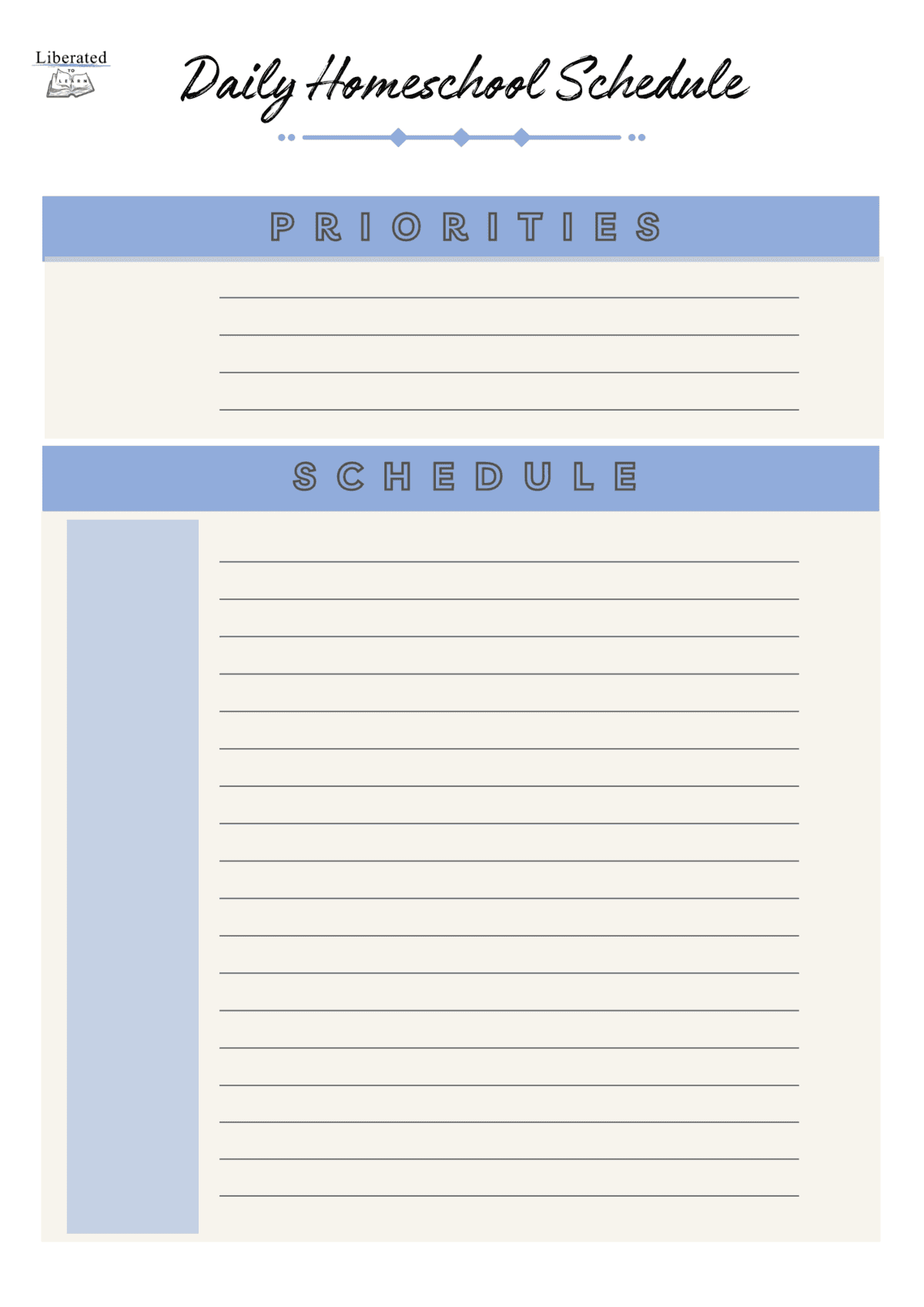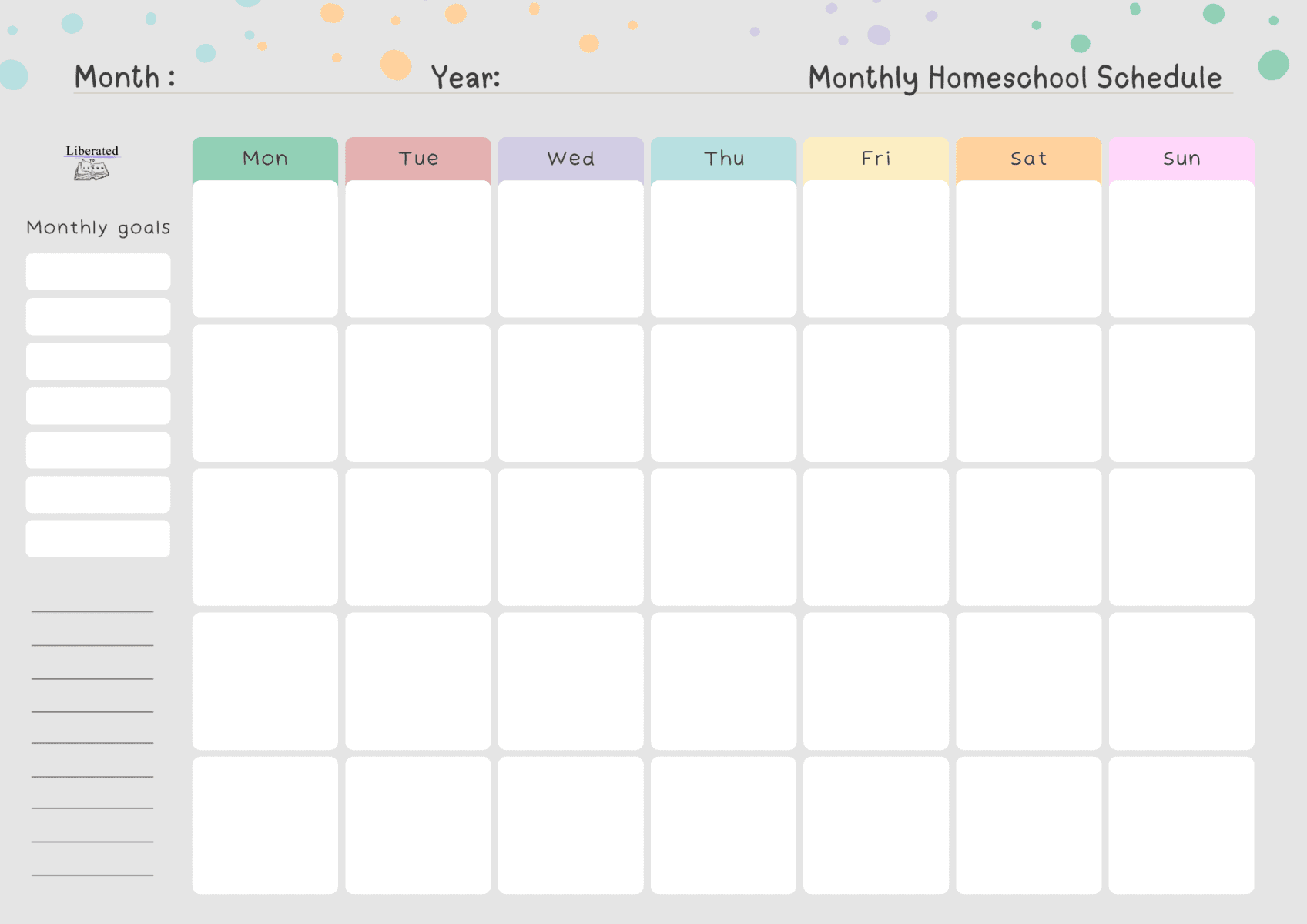To help make things easier, we’re going to go through the benefits of a homeschool schedule and offer tips on how to create your best schedule—one that will work for you and your family.

Not everyone will have the same enthusiasm when they hear the words: homeschool schedule. For a lot of us, it’s a dreaded task because we’re not really sure how to create one which will work for our family. And—to be honest—we won’t know whether it will work until we try it out.
The thought of creating a schedule might put you off if it’s something you’ve not tried before, especially if you love flexibility. Then again, you might be a family that thrives off of structure. But with a homeschool schedule, where do you start?
If you feel like it’s a bit overwhelming, hold on and take a breather. Creating a homeschool schedule doesn’t need to be stressful, and it doesn’t need meticulous planning.
When broken down and taken step by step, it’s a lot easier to work out. And the more schedules you create, the closer you’ll get to figuring out your best schedule. To help make things easier, we’re going through the benefits of a homeschool schedule and offering tips and a step-by-step guide on how to create your best schedule—one that will work for you and your family.
Contents

Benefits of a Homeschool Schedule
1. Keeps you organised!
Organisation is key, right? And when you know what you’ve got planned for the day, week or month, it puts your mind at ease, leaving you feeling like you can take on anything.
2. Adds structure to the day
Whether you’re a lover of schedules or not, a bit of structure is great for children. They will feel more confident and comfortable knowing what to expect and they’ll look forward to the regular activities on their schedule.
You’ll also feel like you can tackle the day without having to worry about what you are doing next because you’ll have everything planned out.
3. You can be as flexible as you like
A schedule doesn’t have to be set in stone. Sometimes, you might find that your schedule isn’t working or that there’s too much or too little on it. That’s why you can chop and change it as much as you like. Finding a schedule that works is all about being flexible and experimenting.
4. You’re less likely to feel overwhelmed
Feeling overwhelmed isn’t nice, but having a schedule definitely keeps you from feeling it so much. And because a schedule helps you to stay organised and structures your day, you won’t feel as unprepared. In fact, if only for a little while, you’ll feel like you’ve got it all figured out!
5. You’ll get more things done!
Getting things done, even those mini accomplishments, is such a wonderful feeling. Who else mentally ticks things off in their head once achieved? And when you’re able to relax at the end of a long day and look back on all the things that your children (and you!) have done, you’ll feel proud and encouraged to do it all again the next day.
Questions To Ask Yourself Before Creating a Homeschool Schedule
Before you even start creating your homeschool schedule, you should ask yourself these 7 questions first. Not only will doing so help you figure out what kind of schedule is going to be best for your family, it will also start you off on the right foot and you’ll be able to plan your schedule better.
- What does my day/week already look like?
- How much time have I got?
- What are our homeschooling goals?
- Which method of homeschooling are we planning to do/ already do?
- Do I have other commitments, like work?
- What extracurricular activities or clubs do my children already attend?
- What is essential and what’s not?
- How will a homeschool schedule improve our homeschooling day?
Tips on Creating Your Perfect Homeschool Schedule
- Try not to do too much at once or squeeze it all in.
- Break your schedule up into manageable chunks.
- Have a few options to fall back on.
- Don’t worry about being consistent. Things change and that’s normal.
- Make sure the schedule suits your family and fits around your lifestyle.
- Be flexible and open-minded.
- You don’t need to make the schedule work; it must work for you.
Step by Step Guide to Creating The Right Homeschool Schedule For Your Family
Schedules are flexible and so are these steps! They can be done in any order you choose!
1. Write down your families’ homeschool goals
The first thing that you might want when creating a homeschool schedule is to write down your families’ homeschool goals. Think about what you want to achieve, what your children want to learn and the goals and aspirations that they have. This will help you to create a schedule that strives towards fulfilling these goals and any future ones.
2. Decide on which learning style you plan to use/ already use
Knowing your learning style can help you to create and adapt your schedule as and when needed. Your schedule will also look different depending on what learning style you choose. If your family decides on unschooling, you’ll likely want to include lots of independent learning on your schedule. If roadschooling is your choice, you’ll want to factor in how much and when you will be travelling.
3. Make a list of everyone’s current commitments
You’ll want to create a list of everyone’s current commitments so that they can be added to your schedule. This could include work commitments, appointments, current clubs and so on. Once everything that needs to be on your schedule is added, you can then start to plan around these commitments.
4. Get input from your children
It’s nice to get input from your children on what the schedule should look like. After all, it’s their schedule too. You could even consider having mini schedules for each of your children if they all do different things and follow a main schedule for everything that you do together.
5. Create categories for your schedule
To make your schedule easier to read and manage, it’s worth creating categories for each of the things you do. Having categories will also help you to work out how much of certain things you do and whether you need to do more or less of something.
6. Outline weekly, monthly and yearly goals
When you outline weekly, monthly and yearly goals, you’ll be able to tailor your schedule to help achieve these goals. Having goals also ensures that you’ll rarely struggle to fill your schedule with things to do because you’ll know what you’ve got to do to eventually reach the goal.
7. Start planning your days
Once you’ve outlined your goals and know your commitments, you can start planning out your days. Remember, not every day needs to look the same and you can be as flexible as you like. If one day is filled with activities, the next day could be more relaxed.
8. Plan for holidays
Going away is always exciting but it also involves a lot of planning, which can throw our schedules off a bit. So, if you know you’ve got an upcoming holiday, plan for it in advance and adapt your schedule so that you’re less likely to feel unprepared or be all over the place nearer the time.
9. Allocate time blocks for different activities and subjects
If you really want to stay organised and you favour a more structured homeschool schedule, you’ll likely want to allocate time blocks for the different activities and subjects that your children do. Having time blocks also ensures that you only spend a certain amount of time doing something. This can prevent your children from burnout when doing too much of one thing.
10. Have space in your schedule for breaks and free time
A good schedule always has space for breaks and free time. And if you allocate a certain amount of time to having a break, you’re more likely to take one because it is part of your schedule. Some of us might mean to take breaks, but if it’s not on our schedule it’s easy to get carried away with the many other things that we need to do. The last thing you want is to fill your schedule with too much, only to realise that it just isn’t possible because it will leave you all feeling more drained than accomplished.
11. Balance learning and having fun
There’s no set rule for how much time should be spent learning and having fun, and balance isn’t necessarily 50/50. What’s important is ensuring that you have the right balance and a balance that works for your children. If they’ve done quite a lot of learning, seem bored or irritable then it’s probably time to schedule in some fun! This is when schedules can get flexible, but go with it. Not everything needs to be planned to a T.
12. Review the schedule regularly
The most important thing to do once you’ve created your homeschool schedule is to review it regularly. What once might have seemed like an ideal schedule and one that worked can soon become one that just isn’t working as well as it should. By discussing what’s working and what’s not, you can make the necessary changes so that everyone stays happy and motivated.
Tips on Adapting Your Homeschool Schedule
When adapting your homeschool schedule, here are a few things you need to keep in mind:
- The changes you make must be doable and not unrealistic.
- Try not to change too much at once.
- Figure out what it is about your schedule that isn’t working ie. timings, activities, structure.
- Make smaller changes over time.
- Adapt to individual needs.
- Start from scratch if you really need to.
Homeschool Schedule Examples
Daily Homeschool Schedules
Because not every day is likely to be the same, a daily homeschool schedule proves useful for those who want to plan their day either first thing in the morning or the night before. It can also be less overwhelming when planning day by day, rather than weekly or monthly.


Weekly Homeschool Schedules
Weekly homeschool schedules are great for people who like to know what their week is going to look like. Although it involves a bit more planning to start with, it’s less hassle than having to think about what you are going to do on the day.


Monthly Homeschool Schedules
For those who like to be prepared and enjoy planning, a monthly schedule is great for long-term goals and knowing which direction you are heading.

Remember, a homeschool schedule can be as simple or at long and detailed as you like. Always do what works best for you and your family!

m@liberated
Want more from Liberated to Learn?
Subscribe to stay updated about new posts, resources and giveaways!












